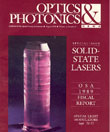
August 1990 Issue
- Diode-pumped mid-infrared solid-state lasers
- New tunable solid-state lasers Cr^3+:LiCaAIF6 and Cr^3+:LiSrAIF6
- Ti:sapphire lasers: Out of the lab and back in again
- SLMs key to optical information processing, displays
- High-power transverse diode-pumped solid-state lasers
- OSA handbook will amplify optical drawing standards
- Interferometry using natural light
- Browse all Issues
Feature Articles
Diode-pumped mid-infrared solid-state lasers
Solid-state lasers pumped by diode lasers are more efficient, compact, and rugged than those pumped by other sources such as lamps.
by Robert C. Stoneman and Leon EsterowitzNew tunable solid-state lasers Cr^3+:LiCaAIF6 and Cr^3+:LiSrAIF6
During the past 10 to 15 years, there has been a resurgence of research and development on tunable solid-state laser materials because of their potential advantages over dye lasers, which have dominated the tunable laser market for many years. These advantages include Jong operating life, a longer energy storage lifetime, reliable and efficient flash lamp pumping, Q-switching, flexible harmonic generation capability, and improved beam quality at high average power levels.
by Lloyd L. Chase and Stephen A. PayneTi:sapphire lasers: Out of the lab and back in again
Tunable solid-state lasers have been with us for a long time, dating back to the demonstration by L.F. Johnson at Bell Labs in 1964 of the Ni:MgF2 laser, the first system of any type with the potential for continuous, broadly tunable oscillation. For many years, tunable solid-state lasers remained as laboratory curiosities and were overshadowed by the dye laser, which offered complete coverage of the near-UV to near-infrared wavelength region.
by Peter F. MoultonSLMs key to optical information processing, displays
The importance of spatial light modulators (SLMs), devices that impose spatial information patterns on optical beams, lies in their being the critical elements of optical information processing, communication, and display systems. Thus SLMs, or light valves, are the key elements in most display applications—from wristwatches and miniature liquid crystal TV monitors, through flat panel displays to high brightness, large screen projectors for theaters, teleconferencing, and flight simulation applications.
by Uzi EfronHigh-power transverse diode-pumped solid-state lasers
The availability of high-power pump diodes has led to a resurgence and development of diode-pumped solid-state lasers.
by Ralph L. BurnhamOSA handbook will amplify optical drawing standards
OSA's Standards Committee is working on a handbook to help flesh out the working draft of the Optical Drawing Standard that is being written by Working Group 2 of ISO/ TC172/SC1. Some sections of this draft will be slightly reworked and the entire document thoroughly edited before it is published as ISO Draft International Standard 10110 in late 1991. However, the working draft contains all of the sections that will be published and there will be no more significant technical changes before publication.
by Robert E. ParksInterferometry using natural light
It is commonly said that lasers are sources of "coherent" light and that thermal sources (the sun, candle flames, incandescent light bulbs, etc.) are sources of "incoherent" light. This notion is bolstered by the relative ease with which we can produce high contrast interference fringes using laser light (indeed, diffraction from dust particles is often apparent whether we want it our not). More fundamentally, as we observe the world illuminated by the sun and other broadband sources, we do not generally observe interference effects.
by Susan Houde-Walter

![Manual probe system with needles for test of semiconductor on silicon wafer. [A. Morozov / Getty]](https://opnmedia.blob.core.windows.net/$web/opn/media/images/articles/2025/1125/departments/202511-cover-web.jpg?ext=.jpg)
![Researcher Clara Saraceno in the lab. [Image by Carsten Behler Photography]](https://opnmedia.blob.core.windows.net/$web/opn/media/images/articles/2025/1025/departments/202510-cover-web.jpg?ext=.jpg)
